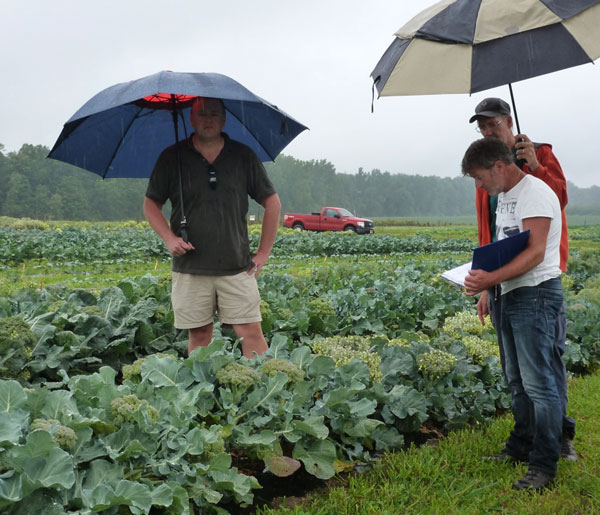At the Eden Valley twilight meeting, Christy Hoepting discussed variety performance with prospective growers in the new packing area of the W.D Henry and Sons. 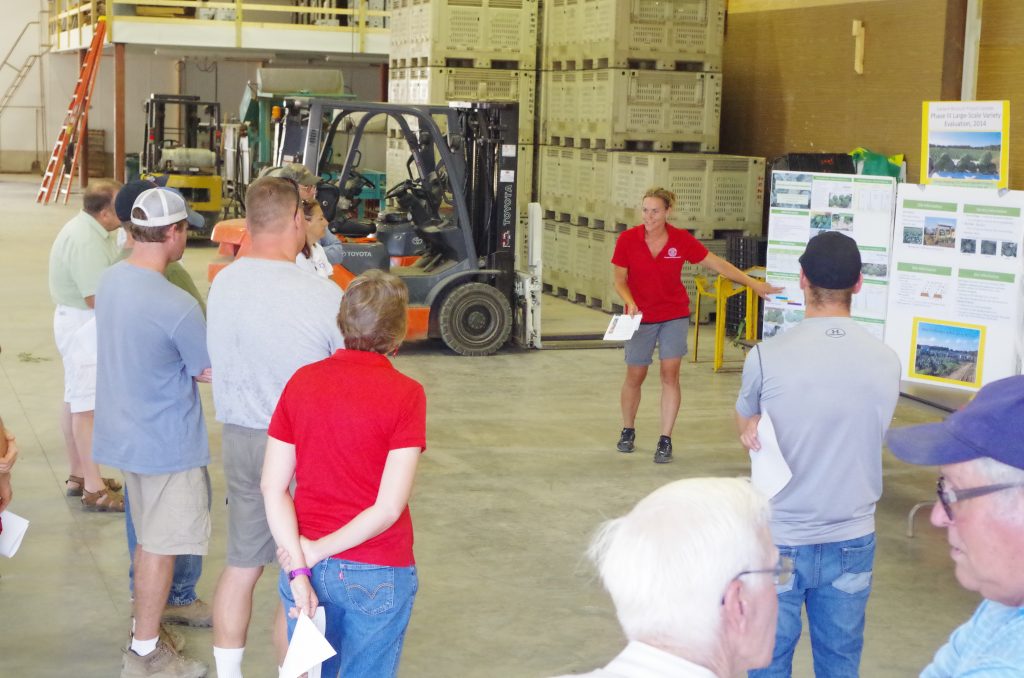
Later, in the field, the Phase III yield trial showed that the new varieties from the project were holding up well in the heat, where the older varieties were suffering.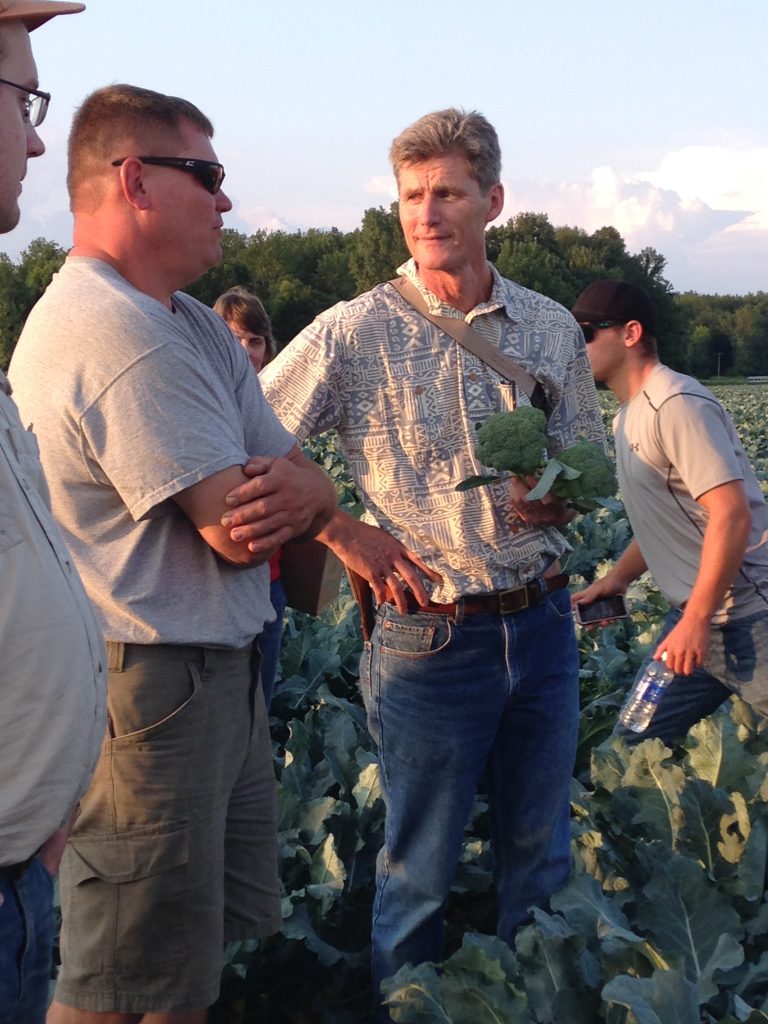
Category Archives: Uncategorized
EDUCATIONAL EVENTS SHOWCASE EASTERN BROCCOLI TRIALS
Eastern Broccoli Project trials will be on display this week as part of educational events in three states.
On Wednesday, August 19, a production trial will be featured in a Fresh Market Vegetable Twilight Meeting at W.D. Henry and Sons in Eden, NY. As part of the event, which runs from 6 to 8:30 pm, Cornell Vegetable Specialist Christy Hoepting and project director Thomas Björkman will lead a tour and discussion of Eastern Broccoli Project trials.
Also on August 19, Carroll County Virginia Extension Agent Suzanne Slack will host an informational session on growing summer broccoli. The event, which is advertised on the Carroll County Extension Facebook page, takes place at 6 pm on at Light’s Farm in Laurel Fork, VA.
From 8:30 am to 12:30 pm on August 20, broccoli project trials will be part of the Alternative Crops and Organics Research Highlights Tour held by Jeanine Davis and Margaret Bloomquist at North Carolina State University’s research station in Waynesville, NC. See http://ncalternativecropsandorganics.blogspot.com for more information.
Our collaborators at Johnny’s Selected Seed have a nice article on timing brassica planting. The article includes good examples of how different brassicas, including broccoli, modify their development in response to temperature. They mention Imperial as the most summer-tolerant in their line. In our trials, two varities that Johnny’s carries, Imperial and Bay Meadows, are standards that have been the ones to beat.
Produce Business on southern vegetable expansion
In the May issue of Produce Business, there is an article on the rapid growth in demand for locally grown vegetables in the southeast. That article is a special box about new varieties. the article highlights broccoli as a key vegetable that has been seeing an effort by regional growers. Powell Smith is quoted about adapting kale production to hot sandy soil, and also noting the sad fact that it has been a decade since Clemson had a vegetable breeding program. Our new collaborator, Tim Coolong at the University of Georgia outlines the many qualities required in varieties for them to thrive in the southeast.
The long search for May-harvested broccoli
A century ago, growers were also eager for broccoli varieties that could be harvested later into spring and early summer.
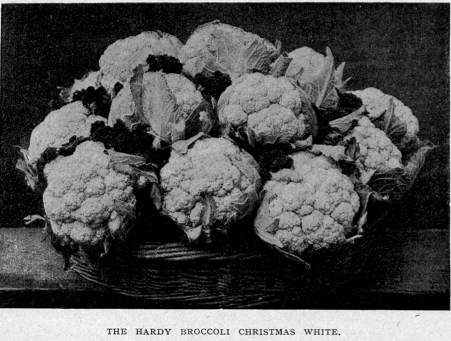
Some of the finest strains of late broccoli, however, are not in commerce, being in the hands of market-men, who have been selecting and re-selecting the stock for the last two or three generations, and from whom it is impossible to beg or buy even a single seed. In course of time, however, these will doubtless pass into the seeds men’s hands, when several late strains, later than anything at present in commerce, will be added to our list of useful varieties.
— F. W. Hammond. Pilgrim’s Hatch, Essex.
In The Garden, February 1917.
This article is about white broccoli, which was raised in England in the late 19th and early 20th century. It looked virtually identical to cauliflower but was cold hardy and raised for cold-season harvest. It was typically planted in the spring and harvested in either late fall or early the following spring. Biennial types headed and were harvested in the spring, but had little heat tolerance. Growers eagerly wanted late varieties that could be harvested in May and still look good.
New GAPs Resources on Eastern Broccoli website
Becoming GAP-certified is essential for commercial growers, but the process can seem daunting – where do you start?!
The GAPs Resources page of the Eastern Broccoli website now features an introduction to Good Agricultural Practices for broccoli growers, including reasons to get certified, an overview of the certification process, and a look at broccoli production with GAPs. Please check out the information if you are growing or thinking about growing broccoli but aren’t yet GAP-certified.
Value of local broccoli published
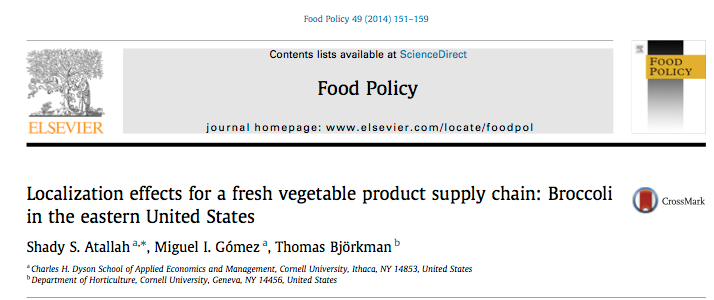 We have a new publication, “Localization effects for a fresh vegetable product supply chain: Broccoli in the eastern United States”. This article models how increasing the Eastern broccoli supply will reduce the overall cost of producing broccoli for the US market, and reduces the carbon footprint as well. The predicted flows of product among different Eastern markets is surprisingly complex.
We have a new publication, “Localization effects for a fresh vegetable product supply chain: Broccoli in the eastern United States”. This article models how increasing the Eastern broccoli supply will reduce the overall cost of producing broccoli for the US market, and reduces the carbon footprint as well. The predicted flows of product among different Eastern markets is surprisingly complex.
This research was part of the doctoral project of Shadi Attalah, who was a graduate student with Miguel Gómez at the Dyson School of Applied Economics and Management at Cornell. Shadi is now an assistant professor at Purdue University.
http://authors.elsevier.com/a/1PZUB15oGokQmh
This link will provide you with free access to the article through October 9, 2014. After that the cost to access the article is substantial. If the large-scale economic effects of locally grown produce is of interest to you, please take a look.
Shady S. Atallah, S., M.I. Gómez and T. Björkman. 2014. Localization effects for a fresh vegetable product supply chain: Broccoli in the eastern United States. Food Policy 49:151–159. DOI: 10.1016/j.foodpol.2014.07.005
Winter broccoli trials in progress in Florida
Dr. Monica Ozores-Hampton and Dr. Lincoln Zotarelli supervise broccoli plantings at new trial locations in Immokalee and Hastings, Florida. These large-scale trials feature an industry standard broccoli variety and two newer commercial hybrids that have displayed superior quality under stressful growing conditions in advanced screening trials. Broccoli varieties will be evaluated based on production-relevant criteria such as yield, number of cuts to harvest, and field holding time. The Hastings trial was direct-seeded in December 2013, while broccoli in the Immokalee trial was transplanted in mid-January 2014. Harvest and evaluation are expected in late winter/early spring 2014. With the addition of the Immokalee and Hastings sites, the Eastern Broccoli project now has trials running in at least one eastern location during every season of the year.
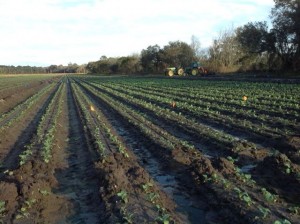
The Alpha Vegetable
The New York Times ran a long Magazine piece about doing an image makeover for broccoli. The goal was to have broccoli be a “cool” food among younger people who don’t care about broccoli at all. Author Michael Moss brought out some important points about the relationship people have with vegetables, as well as the challenges of growing more vegetables in the current economic environment. Our project was mentioned as important, but a drop in the bucket towards that goal.

Commercial breeder visits
The commercial breeders on the project are inspecting trials this late summer, while the differences in quality are most apparent. Brassica breeder Cees Sintinie of Bejo (right front) stopped in Geneva as part of his North American tour. He was accompanied by his colleague Jan van der Heide (rear) when he visited with Phillip Griffiths (left). Characteristic of this summer, the rain was pouring. But rain does not slow this group.


